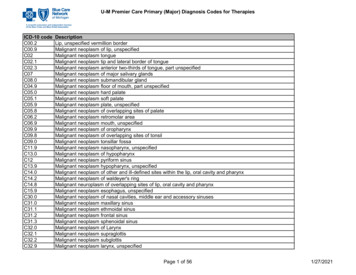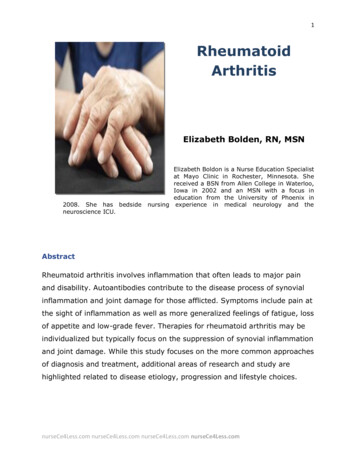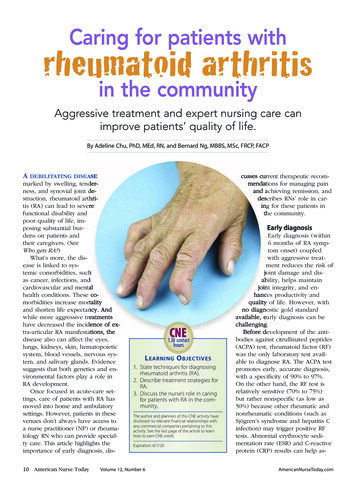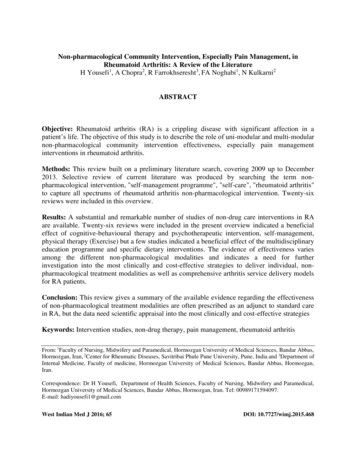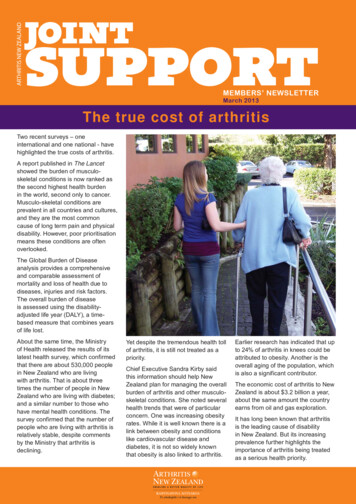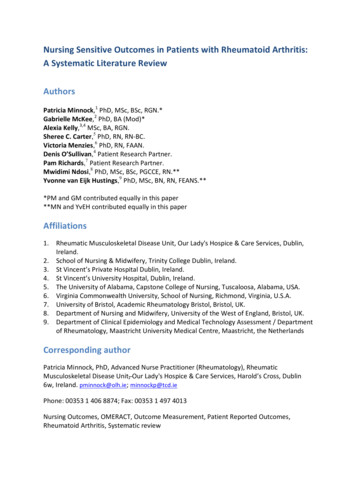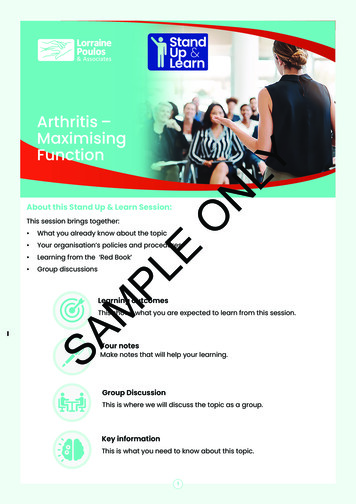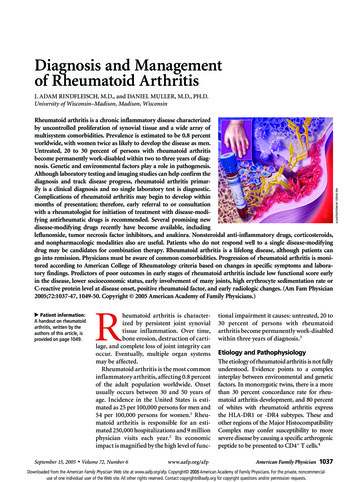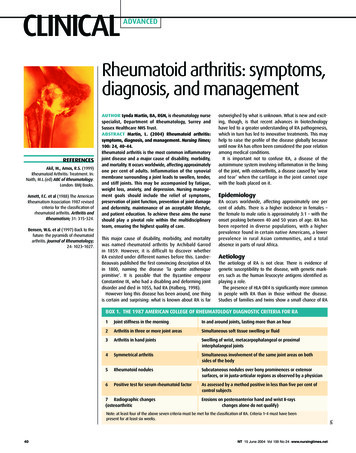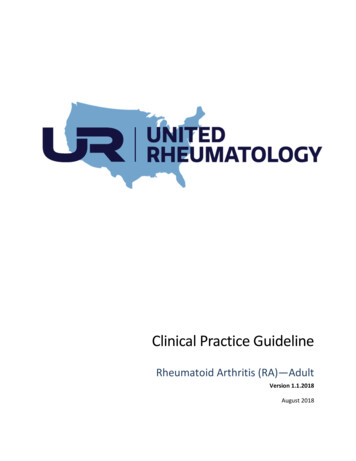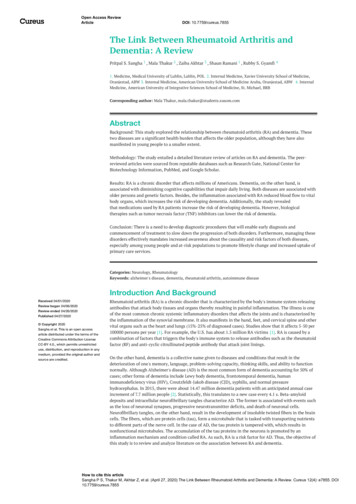
Transcription
Open Access ReviewArticleDOI: 10.7759/cureus.7855The Link Between Rheumatoid Arthritis andDementia: A ReviewPritpal S. Sangha 1 , Mala Thakur 2 , Zaiba Akhtar 3 , Shaun Ramani 1 , Rubby S. Gyamfi 41. Medicine, Medical University of Lublin, Lublin, POL 2. Internal Medicine, Xavier University School of Medicine,Oranjestad, ABW 3. Internal Medicine, American University School of Medicine Aruba, Oranjestad, ABW 4. InternalMedicine, American University of Integrative Sciences School of Medicine, St. Michael, BRBCorresponding author: Mala Thakur, mala.thakur@students.xusom.comAbstractBackground: This study explored the relationship between rheumatoid arthritis (RA) and dementia. Thesetwo diseases are a significant health burden that affects the older population, although they have alsomanifested in young people to a smaller extent.Methodology: The study entailed a detailed literature review of articles on RA and dementia. The peerreviewed articles were sourced from reputable databases such as Research Gate, National Center forBiotechnology Information, PubMed, and Google Scholar.Results: RA is a chronic disorder that affects millions of Americans. Dementia, on the other hand, isassociated with diminishing cognitive capabilities that impair daily living. Both diseases are associated witholder persons and genetic factors. Besides, the inflammation associated with RA reduced blood flow to vitalbody organs, which increases the risk of developing dementia. Additionally, the study revealedthat medications used by RA patients increase the risk of developing dementia. However, biologicaltherapies such as tumor necrosis factor (TNF) inhibitors can lower the risk of dementia.Conclusion: There is a need to develop diagnostic procedures that will enable early diagnosis andcommencement of treatment to slow down the progression of both disorders. Furthermore, managing thesedisorders effectively mandates increased awareness about the causality and risk factors of both diseases,especially among young people and at-risk populations to promote lifestyle change and increased uptake ofprimary care services.Categories: Neurology, RheumatologyKeywords: alzheimer's disease, dementia, rheumatoid arthritis, autoimmune diseaseIntroduction And BackgroundReceived 04/01/2020Review began 04/06/2020Review ended 04/26/2020Published 04/27/2020 Copyright 2020Sangha et al. This is an open accessarticle distributed under the terms of theCreative Commons Attribution LicenseCC-BY 4.0., which permits unrestrictedRheumatoid arthritis (RA) is a chronic disorder that is characterized by the body's immune system releasingantibodies that attack body tissues and organs thereby resulting in painful inflammation. The illness is oneof the most common chronic systemic inflammatory disorders that affects the joints and is characterized bythe inflammation of the synovial membrane. It also manifests in the hand, feet, and cervical spine and othervital organs such as the heart and lungs (15%-25% of diagnosed cases). Studies show that it affects 5-50 per100000 persons per year [1]. For example, the U.S. has about 1.5 million RA victims [1]. RA is caused by acombination of factors that triggers the body's immune system to release antibodies such as the rheumatoidfactor (RF) and anti-cyclic citrullinated peptide antibody that attack joint linings.use, distribution, and reproduction in anymedium, provided the original author andsource are credited.On the other hand, dementia is a collective name given to diseases and conditions that result in thedeterioration of one's memory, language, problem-solving capacity, thinking skills, and ability to functionnormally. Although Alzheimer's disease (AD) is the most common form of dementia accounting for 50% ofcases; other forms of dementia include Lewy body dementia, frontotemporal dementia, humanimmunodeficiency virus (HIV), Creutzfeldt-Jakob disease (CJD), syphilis, and normal pressurehydrocephalus. In 2015, there were about 14.47 million dementia patients with an anticipated annual caseincrement of 7.7 million people [2]. Statistically, this translates to a new case every 4.1 s. Beta-amyloiddeposits and intracellular neurofibrillary tangles characterize AD. The former is associated with events suchas the loss of neuronal synapses, progressive neurotransmitter deficits, and death of neuronal cells.Neurofibrillary tangles, on the other hand, result in the development of insoluble twisted fibers in the braincells. The fibers, which are protein cells (tau), form a microtubule that is tasked with transporting nutrientsto different parts of the nerve cell. In the case of AD, the tau protein is tampered with, which results innonfunctional microtubules. The accumulation of the tau proteins in the neurons is promoted by aninflammation mechanism and condition called RA. As such, RA is a risk factor for AD. Thus, the objective ofthis study is to review and analyze literature on the association between RA and dementia.How to cite this articleSangha P S, Thakur M, Akhtar Z, et al. (April 27, 2020) The Link Between Rheumatoid Arthritis and Dementia: A Review. Cureus 12(4): e7855. DOI10.7759/cureus.7855
ReviewDementiaDementia is a common name for neurological diseases that gradually and permanently impair one's capacityto think and remember things [1]. There is a misconception that dementia affects only old people because ofits commonality in geriatric patients. Evidence shows that it also affects young people with juvenilesshowing significant manifestations [1]. Besides, dementia is considered a syndrome because it alters manybody organs that correlate, such as the brain, respiratory system, endocrine system, and muscles and bones,among other vital organs. The alteration of the functions of these organs results in a series of complicationssuch as functional changes of the brain that affect the autonomous functioning of the patient. Thetreatment of these complications often calls for a multidisciplinary focus. On the other hand, Dr. Barkhofrefers to dementia as a clinical syndrome rather than a disease. The doctor explains that it is an acquiredcondition that is characterized by multiple cognitive impairments that limit the activities of daily living [2].As such, these explanations illustrate that dementia cannot be considered a common brain disease, but agroup of diseases that cause functional alterations of the body's vital organs, which impairs a patient’snormal functioning (social and psychological functioning).Dr. Barkhof reiterated that dementia impairs one's memory, language processing, visual perception, andother executive body functions [2]. The alterations of these body processes make one dependent on his orher principal caretaker. Unfortunately, the onset of dementia cannot be disrupted, but Dr. Barkhof assertsthat it is not necessarily progressive. As such, patients should not lose hope once diagnosed with early-stagedementia. Displayed in Figure 1 shows how millions were deadly impacted in 2012 by dementia worldwide.FIGURE 1: Deaths per million persons in 2012 due to dementia.Courtesy: Extracted from Ref. [2].As for the causes, Dr. Winbald explains that dementia is age-related; aging increases the probability ofdeveloping dementia. The increase in life expectancy and a decrease in the birth rate have resulted in theburgeoning of the older population and a significant increase in dementia cases. Dr. Olney cited a WHOstudy that revealed that dementia in the older population manifests around the age 65-70. However, somepatients show symptoms 10 years earlier before the diagnosis is made [3]. Unfortunately, the assumptionthat such symptoms are synonymous with growing old makes people delay seeking medical attention until2020 Sangha et al. Cureus 12(4): e7855. DOI 10.7759/cureus.78552 of 6
the point when the disease is at an advanced stage. Thus, the delay limits the effective management ofdementia.Dementia's physiopathologyMany diseases are classified as dementia, including Lewy body dementia and Alzheimer's, among others.Besides, few studies have been conducted to understand these diseases, which has resulted in shallowunderstanding of their causes, effects, and characteristics. According to a study by Hinz, dementia is causedby misfolded proteins that transmit their shape to healthy proteins, thereby resulting in changes and leadsto fatal and genetically transmissible neurodegenerative diseases [4]. The study also revealed that some ofthe casual factors for dementia are inflammatory mediators' productions that manifest in other conditionssuch as sarcoidosis, Behcet syndrome, multiple sclerosis, Sjôgren syndrome, among others [5]. Theprogression of these diseases often affects the functioning of the brain in some way, which is a risk factor forthe development of dementia. Other genetic factors included in the study to understand the progression ofAlzheimer include amyloid precursor protein (APP), presenilin-1 (PSEN1), and presenilin-2 (PSEN2) [5].Dementia is a disease that may have typical or atypical presentation [6]. The most typical course of thisdisease includes neurological alterations primarily that may lead to other alterations in many areas of thepatient’s health. Most of the typical symptoms have something to do with neurological damage, such astremors, memory loss, and peripheral manifestations as gastrointestinal habit changes. Also, psychiatricmanifestations are common, and they appear usually as early symptoms because of the mental impact thatthis disease has on the patient [6]. According to this author, the principal mental problems that patientssuffer, include acute appearance of depression or the exacerbation of an episode of depression, generalizedanxiety, suicidal thoughts, to mention the most common ones. In the book “Challenging behavior indementia: a person-centered approach”, published by Stokes in 2017, it is mentioned that the principal areasof treatment, with a person centered focus, may lead to the importance of psychological therapy, as well asmedication, to improve the patient’s quality of life, as well as the correct psychological assessment of thepatient’s family, or at least, the principal caretaker. Stokes makes emphasis on the importance ofpsychological therapy even when the patients are on advanced phases of the disease, because of its provedgood results on the improvement of the patient’s quality of life. It is imperative to co-work with specialistsin many areas, in order to improve many of the patient’s areas and decrease the accelerated usual curse ofthis disease. The multidisciplinary treatment is mandatory, as told by Stokes, so the patients get the best andmost complete intervention, to slow down a bit the evolution of the dementia, to avoid complications andcomorbidities that usually coexist with this disease, and also allow the patient to have a better control ofhis/her body, until the dementia causes structural or great decrease of brain normal functioning. It is wellknown that dementia is a chronic, unstoppable disease, so it is impossible to avoid the natural curse of it,but that does not mean that patients have to suffer each phase of the disease. According to Stokes,psychological plus medical treatment may create a more comfortable ambience for the patient and his/herfamily, in order to provide appropriate closure and better quality of life for everyone. Dementia is a diseasethat causes many several changes in the patient’s life and, obviously, in the family dynamics because of theconsequences that it generates. Many of the patients with this disease have too many neurological, motor,and psychological symptoms by the time of diagnosis because of the progressive and nonspecific course ofthe disease, which does not permit the patient or family to notice it early. It is well known that dementia hasa particular genetically related factor, which means that people with this disease will transmit it to furthergenerations very probably and also have family history of it in any way. The most important behavior on therecognition and treatment of this disease is prevention. Specially knowing which patients are at risk becauseof family history of dementia, and also, those who have other diseases that increase the possibilities todevelop any type of dementia. “Acting now on dementia prevention, intervention, and care will vastlyimprove living and dying for individuals with dementia and their families, and in doing so, will transformthe future for society” [2]. This is a very important principle that should regulate the acting on this disease,in order to decrease the risks and consequences; and increase the treatment alternatives. Although, byunderstanding the dementia's course and causes, medicine and science in general are making gigantic stepson this improvement objectives; even if it’s a disease that affects old people; because by caring about oldpatients, is unavoidable to change younger people’s conscience.Moreover, dementia affects the life of apatient and his or her family significantly. Most of the patients develop neurological, motor, andpsychological symptoms by the time of diagnosis that were not noticed earlier because of the slowprogression and nonspecific course of the disease. As displayed in Figure 2, visual differences are clearlynoted in the patients brain in regards to structure and form. The genetic predisposition of dementia makes ita generational burden, which makes it a familial burden. The ideal mode of recognizing and treating it isbased on prevention [7]. The process entails assessing familial history to identify the people at risk ofdeveloping the disorder and implementing interventions aimed at limiting its manifestation. Studies showthat early dementia prevention and care will improve the quality of life for patients with dementia and theirfamilies [7]. This is an important principle that should guide interventions aimed at managing dementiabecause it will help reduce the risk and effects of the disease as well as increase treatment alternatives. Thus,by understanding the dynamics of dementia (its causes, progression, effects, and treatment options),stakeholders will develop interventions that will improve the quality of life of old patients and change theyoung people's perceptions of the disease.2020 Sangha et al. Cureus 12(4): e7855. DOI 10.7759/cureus.78553 of 6
FIGURE 2: Differences between healthy brain structure (A) anddementia patient's brain structural changes (B).Courtesy: Extracted from Ref. [2].Rheumatoid arthritisRheumatoid arthritis is a chronic disorder of the immune system that is characterized by the release ofantibodies that attack and destroy body tissues and organs, including the skin, blood vessels, heart, lungs,and muscles [8]. Its most common manifestation is the weakening and inflammation of the joints thatgradually progresses to the destruction of the articular cartilage and ankylosis of the joints. It mainly affectsthe proximal interphalangeal and the metacarpophalangeal (MCP) [8]. The chronic inflammation results inthe formation of pannus, which consists of inflammatory cells, granulation tissues, and synovial fibroblasts.The diagnosis of RA is only possible when there are at least four of seven features, which makes earlydiagnosis difficult because of the variance of signs and symptoms over time. However, early diagnosis andtreatment may help to slow down the progression of the disease.The most reliable form of diagnosing RA currently entails the analysis of the ulnar deviation of MCP joints.The common symptoms of RA include fatigue, depression, morning stiffness that lasts more than one hour,stiffness and/or swelling of the joints such as MCP joints, proximal interphalangeal (PIP) joints, andmetatarsophalangeal (MTP) joints [8]. Besides, physical examinations may reveal symptoms such as anemiaof chronic disease, weight loss, decreased grip strength, palmar erythema, subcutaneous (rheumatoid)nodules, splenomegaly in cases of Felty syndrome, ulnar deviation of the fingers, swan neck deformity, andboutonniere deformities [8].Additionally, RA is common in middle-aged women. However, it can manifest at any age and is geneticallylinked to the HLA-DR4 gene. It is also associated with environmental factors and antigens that includesmoking, Epstein-Barr virus (EBV), and mycoplasma. As such, people with a family history of RA are at anelevated risk of developing this chronic disease [8]. The study by Le and Bhushan revealed that 80% of thosediagnosed with a positive rheumatoid factor have an accumulation of IgM autoantibodies to the Fc portionof autologous IgG [9]. The study also revealed the accumulation of citrullinated proteins (substitution ofarginine by citrulline amino acid) that is caused by inflammation and antibodies against citrullinatedproteins.Rheumatoid arthritis occurs when the body's immune system releases antibodies that attack the inner liningof the membranes surrounding the joints known as the synovium [9]. The synovium thickens as a result ofthe inflammation, which eventually results in the destruction of the cartilage and bone within thejoint [9]. An infection often triggers this chain of events in a genetically susceptible person that results inthe infiltration of the synovial stroma by CD4 helper T cells, B cells, plasma cells, dendritic cells, andmacrophages [9]. These result in increased vascularity caused by vasodilation and angiogenesis, withsuperficial hemosiderin deposits and aggregation of organizing fibrin floating in the joint space known asrice bodies. Neutrophils also accumulate in the synovial fluid causing juxta-articular erosions, subchondralcysts, and osteoporosis.Overall, these studies show that RA is caused by T- and B-cell responses to an infection in a geneticallysusceptible person, which results in the formation of pannus and eventual damage of the adjacent cartilageand bone. The Th1 cells release interferon-γ (IFN-γ) to activate macrophages and synovial cells, and theTh17 cells secrete interleukin-17 (IL-17) to recruit monocytes and neutrophils synovial plasma cells produceantibodies against self-antigens such as citrullinated peptides [9]. Cumulatively, these biological reactionsand changes result in the development of RA.2020 Sangha et al. Cureus 12(4): e7855. DOI 10.7759/cureus.78554 of 6
Pathogenesis of dementia in rheumatoid arthritis patientsPatients with RA have displayed symptoms that put them at an elevated risk of developing dementia. Acommon hypothesis put forward to explain this risk is that the chronic inflammation associated with RAreduces blood circulation. As such, increased inflammation decreases the supply of blood to the brain.Ischemic or hemorrhagic infarcts can cause vascular dementia in many areas of the brain [9-10]. The riskfactors for vascular dementia include increased age (over 65 years), hypertension, hyperlipidemia, diabetes,genetics, and smoking/alcohol use. This is shown in Figure 3 as the linkage between vascular dysfunctionand neurodegeneration . These risk factors are associated with reduced blood flow that increases the risk ofdeveloping dementia. The damage caused by RA leads to atrophy and degeneration of parts of the brain thatcan affect cognition and behavior [10]. Extensive damage may result in incoherent thought processes,memory loss, and the incapacity to perform routine tasks. A study on the effects of midlife RA revealed anincrease in the risk of cognitive impairment and Alzheimer's dementia [10-11]. The main pathologicalhallmarks of AD are the extracellular deposition of β-amyloid plaques and intra-neuronal neurofibrillarytangles. The increase in the levels of inflammatory signals and cytokines and cerebral inflammation causedby β-amyloid plaque deposition is responsible for the pathophysiology of RA (IL-1, IL-6, and TNF) [12]. Thelink between AD and the expression of IL-1 reveals a restraint in the function of cholinergic systems and anaccumulation of Aβ plaques that initiates dementia and neurofibrillary tangles that are involved in itsprogression [12-13]. Studies have also shown that medication used by RA patients also increases the risk ofdeveloping dementia. Notably, conventional synthetic disease-modifying anti-rheumatic drugs (csDMARDS)such as methotrexate, hydroxychloroquine, and sulfasalazine have a higher risk (1.63-fold) of dementia thanthose who do not use csDMARDS [13-14]. However, biological therapies, such as tumor necrosis factor (TNF)inhibitors, can lower the risk of dementia [14-15].FIGURE 3: Vascular hypothesis explaining the link between vasculardysfunction and neurodegeneration in AD.AD, Alzheimer's disease.Courtesy: Adapted from Ref. [15].ConclusionsOverall, this study revealed that the development of RA increases the risk of developing dementia. Firstly,both have a genetic predisposition, which makes their effective management critical to ensuring improvedquality of life for both patients and their families. Dementia is associated with the deterioration of one'smemory, language processing, visual perception, and other executive bodily functions to the extent that onebecomes dependent on a caregiver. RA, on the other hand, is associated with the immune system releasingantibodies that attack healthy body tissues and organs and joints, which leaves one physically impaired. Theinflammation affects blood flow in the body, which limits brain functions because of limited oxygen supply.Other vital organs also lack adequate blood flow, which limits their functioning. These changes increase therisk of developing dementia. The study also revealed that these health issues manifest mostly in olderpeople aged above 65. The findings reinforce the need to develop diagnostic procedures that will enableearly diagnosis and commencement of treatment to slow down the progression of both disorders.Furthermore, there is a need for increased awareness about the causality and risk factors of both diseases,especially among young people and at-risk populations to promote lifestyle change and increased uptake ofprimary care services. These will help reduce the prevalence and progression of both RA and dementia.2020 Sangha et al. Cureus 12(4): e7855. DOI 10.7759/cureus.78555 of 6
Additional InformationDisclosuresConflicts of interest: In compliance with the ICMJE uniform disclosure form, all authors declare thefollowing: Payment/services info: All authors have declared that no financial support was received fromany organization for the submitted work. Financial relationships: All authors have declared that they haveno financial relationships at present or within the previous three years with any organizations that mighthave an interest in the submitted work. Other relationships: All authors have declared that there are noother relationships or activities that could appear to have influenced the submitted .Wallin K, Solomon A, Kåreholt I, Tuomilehto J, Soininen H, Kivipelto M: Midlife rheumatoid arthritisincreases the risk of cognitive impairment two decades later: a population-based study. J Alzheimer's Dis.2012, 31:669-667. 10.3233/JAD-2012-111736Livingston G, Sommerlad A, Orgeta V, Costafreda SG, Huntley J, Ames D, Cooper C: Dementia prevention,intervention, and care. Lancet. 2017, 390:2673-2734. 10.1016/S0140-6736(17)31363-6Barkhof F, van Buchem MA: Neuroimaging in dementia. Diseases of the Brain, Head and Neck, Spine 20162019. Hodler J, Kubik-Huch RA, von Schulthess GK (ed): Springer, New York; 2019. 79-85.Olney NT, Spina S, Miller BL: Frontotemporal dementia. Neurol Clin. 2017, 35:339-374.10.1016/j.ncl.2017.01.008Hinz FI, Geschwind DH: Molecular genetics of neurodegenerative dementias . Cold Spring Harbor PerspectBiol. 2017, 9:023705. 10.1101/cshperspect.a023705Stokes G: Challenging Behavior in Dementia: A Person-Centered Approach . Taylor & Francis, 2017.Winblad B, Amouyel P, Andrieu S, et al.: Defeating Alzheimer's disease and other dementias: a priority forEuropean science and society. Lancet Neurol. 2016, 15:455-532. 10.1016/S1474-4422(16)00062-4Rheumatoid arthritis. (2020). Accessed: March 26, 2020: matoid-arthritis/symptoms-causes/syc-20353648.Le T, Bhushan V: First Aid for the USMLE Step 1 . McGraw-Hill Education, New York; 2019.Sattar H: Fundamentals of Pathology . Pathoma LLC, Lincolnwood, IL; 2018.Love S: Neuropathological investigation of dementia: a guide for neurologists . J Neurol NeurosurgPsychiatry. 2005, 76:5. 10.1136/jnnp.2005.080754Su F, Bai F, Zhang Z: Inflammatory cytokines and Alzheimer’s disease: a review from the perspective ofgenetic polymorphisms. Neurosci Bull. 2016, 32:469-480. 10.1007/s12264-016-0055-4Chou MH, Wang JY, Lin CL, Chung WS: DMARD use is associated with a higher risk of dementia in patientswith rheumatoid arthritis: a propensity score-matched case-control study. Toxicol Appl Pharmacol. 2017,1:217-222. 10.1016/j.taap.2017.09.014Mason A, Holmes C, Edwards CJ: Inflammation and dementia: using rheumatoid arthritis as a model todevelop treatments?. Autoimmune Rev. 2018, 17:919-925. 10.1016/j.autrev.2018.04.001Rius-Pérez S, Tormos AM, Pérez S, Taléns-Visconti R: Vascular pathology: cause or effect in Alzheimerdisease?. Neurol Vol. 2018, 33:112-120.2020 Sangha et al. Cureus 12(4): e7855. DOI 10.7759/cureus.78556 of 6
Background: This study explored the relationship between rheumatoid arthritis (RA) and dementia. These two diseases are a significant health burden that affects the older population, although they have also manifested in young people to a smaller extent. Methodology: The study entailed a d

